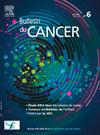Recommandations françaises de prise en charge des tumeurs d’Ewing métastatiques extra-pulmonaires (GroupOs)
IF 0.8
4区 医学
Q4 ONCOLOGY
引用次数: 0
Abstract
Le pronostic des patients atteints d’un sarcome d’Ewing avec métastases extra-pulmonaires est sombre. Un protocole français récent, CombinaiR3, a eu pour but d’évaluer l’efficacité chez ces patients d’une chimiothérapie d’induction, suivie par une chimiothérapie haute dose et un traitement d’entretien métronomique. Dans l’attente des résultats de ce protocole, nous proposons un consensus national français sur la prise en charge de ces patients. Le schéma global proposé reprend dans les grandes lignes celui de CombinaiR3. Concernant la prise en charge initiale, une chimiothérapie d’induction alternant les cures de vincristine/doxorubicine/cyclphosphamide et d’ifosfamide/étoposide, pour un total de neuf cures est recommandée. En cas de réponse radiologique et/ou métabolique insuffisante, un switch pour un autre schéma de chimiothérapie ou l’inclusion dans un essai thérapeutique devront être discutés. Le traitement local est essentiel dans la prise en charge des patients avec un sarcome d’Ewing. Il consiste en une chirurgie et/ou radiothérapie. Il devra être discuté si possible en amont dès le diagnostic et réalisé par des experts travaillant au sein du réseau sarcomes. Une chimiothérapie haute dose par busulfan et melphalan avec support de cellules souches hématopoïétiques pourra ensuite être administrée si elle est compatible avec le traitement local notamment radiothérapie. Ce programme thérapeutique se terminera par un traitement d’entretien métronomique pendant deux ans.
Patients who develop Ewing sarcoma with extra-pulmonary metastasis have a poor prognosis. A recent French protocol, CombinaiR3, was set up to evaluate the efficacy of induction chemotherapy followed by high-dose chemotherapy and metronomic maintenance treatment. It is now closed for inclusions and while waiting for the results, we propose a French consensus guideline for the management of patients diagnosed with Ewing sarcoma with extra-pulmonary dissemination. Main recommendations include induction chemotherapy with nine cycles of vincristine/doxorubicin/cyclophosphamide alternating with ifosfamide/etoposide. In case of insufficient response, other chemotherapy combination or inclusion in a clinical trial should be considered. Induction chemotherapy should be followed by local treatment, consisting of surgery and/or radiotherapy. Optimal local treatment is a milestone in the management of patients with Ewing sarcoma and should be discussed with experts and surgeons/radiotherapists working in the sarcoma network. High-dose chemotherapy (HDC) containing busulfan and melphalan followed by autologous stem-cell transplantation is still unclear, with contradictory results. HDC will then be discussed in national tumor board and administered to patients when compatible with local treatment. Given the high relapse rate observed among these metastatic patients, maintenance chemotherapy (so called metronomic regimen) will then be given for two years.
[肺外转移性尤因肉瘤:法国小组的诊断和治疗建议]。
尤因肉瘤合并肺外转移的患者预后较差。法国最近制定了一项方案,CombinaiR3,以评估诱导化疗后高剂量化疗和节律维持治疗的疗效。在等待结果的同时,我们提出了一项法国共识指南,用于诊断为肺外播散的尤文氏肉瘤患者的管理。主要建议包括诱导化疗,长春新碱/阿霉素/环磷酰胺与异环磷酰胺/依托泊苷交替使用9个周期。如果反应不足,应考虑其他化疗联合或纳入临床试验。诱导化疗后应进行局部治疗,包括手术和/或放疗。最佳局部治疗是尤文氏肉瘤患者管理的一个里程碑,应该与肉瘤网络中的专家和外科医生/放射治疗师讨论。高剂量化疗(HDC)含有布苏芬和美伐兰,然后自体干细胞移植仍不清楚,结果矛盾。HDC将在国家肿瘤委员会进行讨论,并在与当地治疗相适应时给予患者。鉴于在这些转移性患者中观察到的高复发率,维持化疗(所谓的节拍疗法)将给予两年。
本文章由计算机程序翻译,如有差异,请以英文原文为准。
求助全文
约1分钟内获得全文
求助全文
来源期刊

Bulletin Du Cancer
医学-肿瘤学
CiteScore
1.90
自引率
16.70%
发文量
224
审稿时长
37 days
期刊介绍:
Without doubt, the ''Bulletin du Cancer'' is the French language publication of reference in the field of cancerology. Official organ of the French Society of Cancer, this journal covers all the information available, whether in the form of original articles or review articles, but also clinical cases and letters to the editor, including various disciplines as onco-hematology, solids tumors, medical oncology, pharmacology, epidemiology, biology as well as fundamental research in cancerology. The journal proposes a clinical and therapeutic approach of high scientific standard and regular updates in knowledge are thus made possible. Articles can be submitted in French or English.
 求助内容:
求助内容: 应助结果提醒方式:
应助结果提醒方式:


